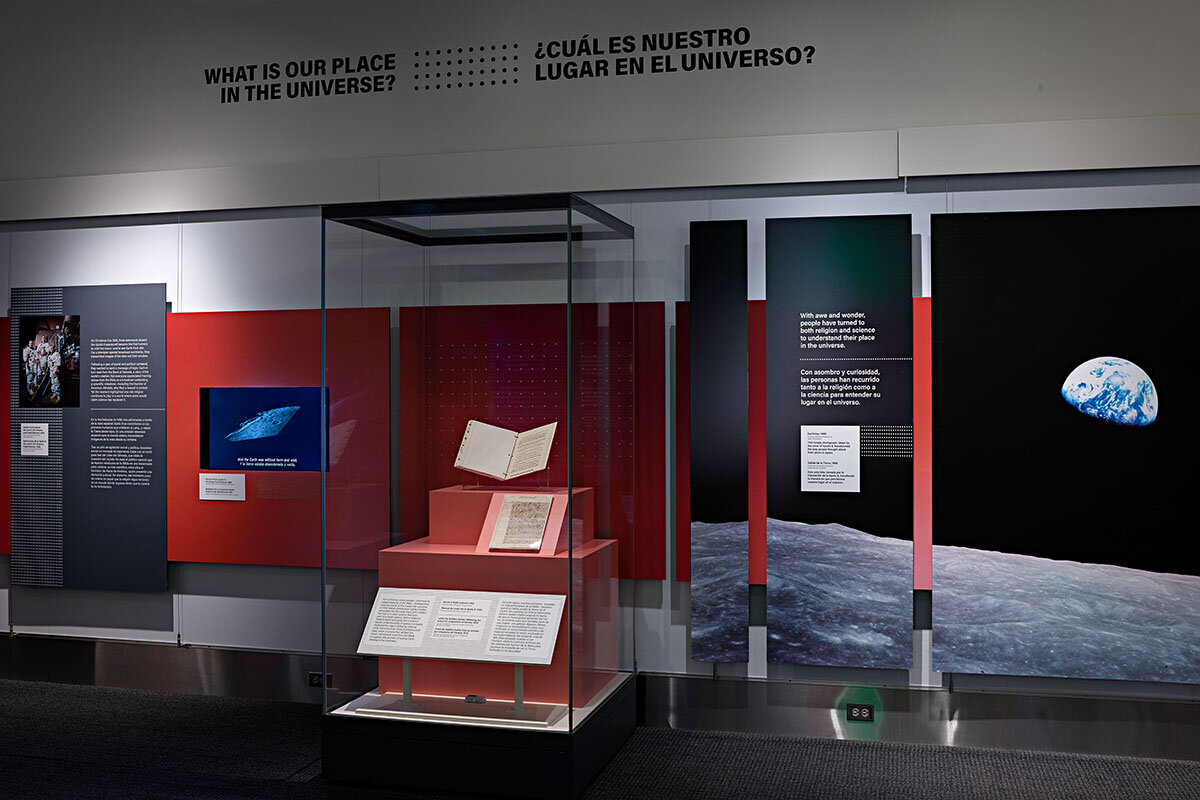Science and religion: Smithsonian exhibit explores the intersections
Loading...
| Washington
Many people assume there is a conflict between science and religion, but a new exhibit at the Smithsonian Institution’s National Museum of American History aims to show that the intersection of the two in American culture is broader than conflict.
The yearlong exhibit – “Discovery and Revelation: Religion, Science, and Making Sense of Things” – is framed by three questions: “What does it mean to be human?” “What do we owe each other?” and “What is our place in the universe?”
Why We Wrote This
Science and religion are cultural lenses for understanding the world – and they often conflict. But a new Smithsonian exhibit aims to show where they intersect and inspire.
An instance of accord between the lenses of science and religion is captured in a display of the Apollo 8 mission to the moon. Encased in glass is a flight manual opened to the page of Bible text that the three astronauts read in a broadcast back to Earth from their 1968 Christmas Eve orbit of the moon. The inspiration of that moment comes through decades later in the exhibit’s crackly video loop of the reading of the ancient Genesis creation story aboard a scientifically engineered spacecraft.
The curator of the exhibit, Peter Manseau, says, “What we’ve seen is that the intersection of religion and science is still very present in our approach and our interpretation of what to do in the face of something like a pandemic.”
At the end of tumultuous 1968 – a year of political assassinations, war, riots, the crushing of the Prague Spring – the view from Earth was bleak. The world needed hope – and Apollo 8 astronauts orbiting the moon on Christmas Eve read the creation text from Genesis’ first chapter to a billion listeners.
The inspiration from the astronauts reading Old Testament Scripture on a scientifically engineered spacecraft comes through even decades later and on a crackly video loop in the new exhibit “Discovery and Revelation: Religion, Science, and Making Sense of Things” at the Smithsonian Institution’s National Museum of American History.
Such intersections of religion and science in American culture are part of the focus of the yearlong exhibit.
Why We Wrote This
Science and religion are cultural lenses for understanding the world – and they often conflict. But a new Smithsonian exhibit aims to show where they intersect and inspire.
Many people assume that there is a conflict between science and religion, says Peter Manseau, the exhibit curator. But he wants visitors to walk away realizing that the interaction is much broader than a story of conflict alone.
“The challenge was trying to expand the terms of engagement with which religion and science are usually discussed,” says Mr. Manseau.
To accomplish that, three prompting questions frame the exhibit: “What does it mean to be human?” “What do we owe each other?” and “What is our place in the universe?”
Packed into the 1,200-square-foot space are artifacts to explore those inquiries. For example, the Apollo 8 flight manual, Charles Darwin’s 1860 book “On the Origin of Species” establishing his theory of evolution, and the message from the first public demonstration of the telegraph in the 1840s (“What hath God wrought?”) are all displayed.
“It’s small enough for people to appreciate the theme,” says Lisa Deason, a member of the Guild of Professional Tour Guides of Washington, D.C., at an exhibition preview in March. “I think it will spur on some thinking.”
The exhibit proceeds both chronologically and thematically. Roughly chronological displays line the walls, starting with the 1700s and closing with the Apollo 8 message. In keeping with museum policy, all text is shown in both English and Spanish.
“We’re trying to tell a story of American history that is as diverse as the American people,” says Mr. Manseau, noting the exhibit’s displays of many faiths.
The exhibit includes a portrait of Henrietta Lacks, a young African American mother who had cancerous cells that were used by medical researchers after her death in 1951 without her or her family’s permission. In the portrait, she stands, hands clasping a Bible, with the prompting question above her: “What do we owe each other?”
Mr. Manseau sees parallels between past and present, especially related to the pandemic that transpired as the collection was pulled together over the past three years. He points out the “Faith and Healing” display that shows pamphlets arguing for and against smallpox inoculations in 1721 and 1722. Conversations in Boston three centuries ago, he says, mirrored those that took place over the past few years.
“What we’ve seen is that the intersection of religion and science is still very present in our approach and our interpretation of what to do in the face of something like a pandemic,” says Mr. Manseau, author of a book about Thomas Jefferson’s Bible, where the third president excised Jesus’ healings and metaphysical statements. (That 1820 book by Jefferson interpreting the Bible, “The Life and Morals of Jesus of Nazareth,” is also on display.)
In the middle of the exhibit, between display cases that line the walls, are panels of eight people whose words are displayed next to other thematic questions such as: “Can religion be scientific?” The founder of this newspaper, Mary Baker Eddy, is included on the panel with that question, as is a partial quote from her book, “Science and Health with Key to the Scriptures.”
Mr. Manseau, who co-wrote a new book with the same title as the exhibit, says he wants visitors to walk away asking new questions: “We’re not trying to solve this riddle or to answer this question definitively.”
“Discovery and Revelation: Religion, Science, and Making Sense of Things” runs through March 1, 2023.










